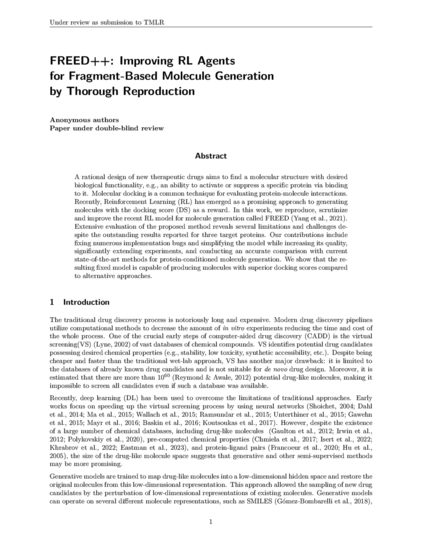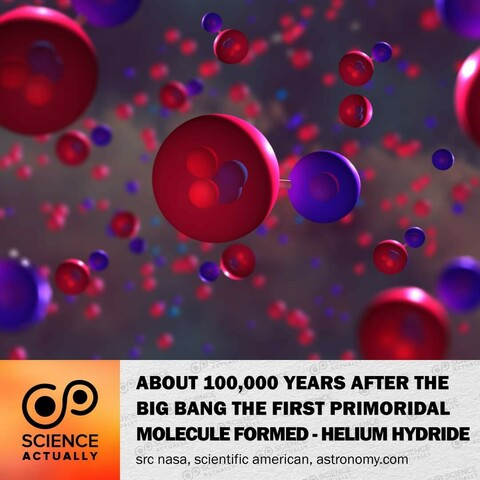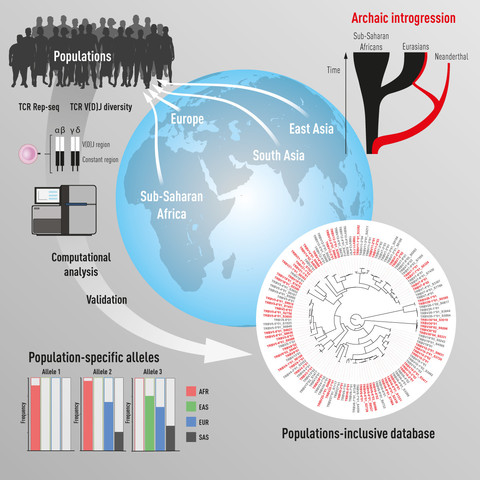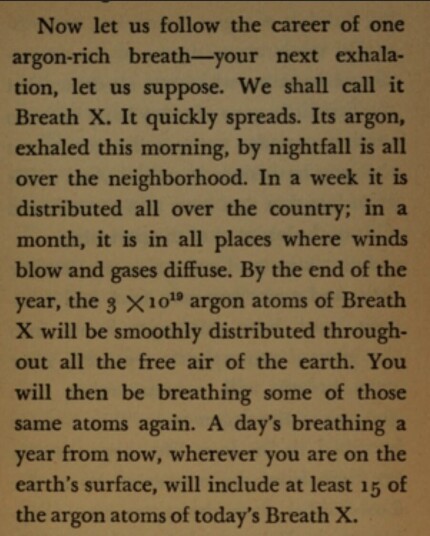New Submissions to TMLR · @tmlrsub
206 followers · 757 posts · Server sigmoid.socialFREED++: Improving RL Agents for Fragment-Based Molecule Generation by Thorough Reproduction
New Submissions to TMLR · @tmlrsub
199 followers · 704 posts · Server sigmoid.social3D Molecular Generation via Virtual Dynamics
#molecule #molecules #molecular
Oden · @Gjallarhornet
926 followers · 7687 posts · Server mastodon.nu#AI May Have Found The Most Powerful Anti-Aging #Molecule Ever Seen
https://www.sciencealert.com/ai-may-have-found-the-most-powerful-anti-aging-molecule-ever-seen
Daniel Probst · @skepteis
2225 followers · 902 posts · Server skepteis.socialIn case you've been wondering what a molecule looks like from the inside—at least a rendered one. ;-)
ScienceActually · @scienceactually
56 followers · 201 posts · Server sfba.socialAbout 100,000 years after the Big Bang, the first primordial molecule formed - helium hydride.
#science #sciencefacts #bigbang #hydrogen #molecule #HeliumHydride
#science #sciencefacts #bigbang #hydrogen #molecule #heliumhydride
Knowledge Zone · @kzoneind
211 followers · 1155 posts · Server mstdn.social#Molecule in mothers’ #Milk nurses pups’ #Heart cells to maturity ($) : Nature
A #Paralyzed Man Can Walk Naturally Again With #Brain and #Spine #Implants : NY Times
Strange #StarSystem may hold first evidence of an ultra-rare '#DarkMatter star' : Live Science
Check our latest #KnowledgeLinks
#knowledgelinks #darkmatter #StarSystem #implants #spine #brain #paralyzed #heart #milk #molecule
WordofTheHour · @wordofthehour
2241 followers · 34689 posts · Server botsin.space#molecule : one of the very small invisible particles of which all matter is supposed to consist
- French: molécule
- German: das Molekül
- Italian: molecola
- Portuguese: molécula
- Spanish: molécula
------------
Report an incorrect translation @ https://wordofthehour.org/r/translations
🌬 NorthWind · @NorthWind
674 followers · 818 posts · Server mstdn.social@wonderofscience
In addition to the #Airglow phenomena, I am mesmerized by watching our beautiful #Earth with its protective atmosphere bubble rotating in the vastness of #space. There we are. That’s us! All of humanity, each individual person’s life, their thoughts, struggles & triumphs. Every Country, every #race, every #species, every #SentientBeing, every #molecule. Absolutely #breathtaking !
#WeAreNotAlone #awakeningconsciousness #WeAreAllConnected #breathtaking #molecule #SentientBeing #species #Race #Space #Earth #airglow
Published papers at TMLR · @tmlrpub
510 followers · 329 posts · Server sigmoid.socialChemSpacE: Interpretable and Interactive Chemical Space Exploration
Yuanqi Du, Xian Liu, Nilay Mahesh Shah, Shengchao Liu, Jieyu Zhang, Bolei Zhou
#chemspace #molecule #generative
Caliz'Craft · @Calizcraft
48 followers · 452 posts · Server piaille.frLa #Molécule de #Chocolat brodée au #Pointderoix est terminée !
Design de ZephyrMood sur Etsy
Fruit de 9h de travail, vous pouvez l'acheter juste ici :
Calizcraft.fr
#nouveau #molecule #chocolat #pointderoix #artisanat #faitmain
DiverseTCR · @Saligramalab
63 followers · 50 posts · Server mstdn.social#Great #article on the #molecule I #LOVE the #most -#TCR @ImmunityCP @NillaKH
---
RT @NillaKH
Our new paper by Corcoran et al., just out in @ImmunityCP, reveals a high variation in human T cell receptor germline genes. The alleles vary greatly in frequency between population groups and some are, surprisingly, inherited from our archaic relatives. https://authors.elsevier.com/sd/article/S1074-7613(23)00038-9
https://twitter.com/NillaKH/status/1625906243175952408
#TCR #most #love #molecule #article #great
Bibiana Prinoth · @bibianaprinoth
503 followers · 392 posts · Server astrodon.socialSo why are these line lists important for me? 🥺
Broadly speaking I am using them to figure out what fingerprint a given #atom or #molecule would imprint on the spectrum of the #planet. For some atoms the line lists are very accurate, and allow us to confidently detect these in atmospheres by comparing the spectrum to the predictions. For others, the lists are less accurate and more difficult to calculate. Mostly for molecules. This means it is VERY hard to match the fingerprints. #SEHR2023
#atom #molecule #planet #sehr2023
Ray Ryan · @rjrjr
437 followers · 1247 posts · Server mastodon.socialI got a big thing wrong in 👆 this talk 👆: I said that Compose's support for novel form factors requires paying the old configuration change tax, and coping with multiple Activity instances.
I'm told that this is false, and the strong guidance of the #Compose team continues to be to set your manifest handle all config changes manually. With that done, an #Android app rooted in Compose UI has no reason to use #Molecule for anything outside of testing.
WordofTheHour · @wordofthehour
2092 followers · 31901 posts · Server botsin.space#molecule : one of the very small invisible particles of which all matter is supposed to consist
- French: molécule
- German: das Molekül
- Italian: molecola
- Portuguese: molécula
- Spanish: molécula
------------
Report an incorrect translation @ https://wordofthehour.org/r/translations
Mauricio Teixeira 🇧🇷🇺🇲 · @badnetmask
152 followers · 554 posts · Server hachyderm.io@RobLangford @copyrights
I came here to say something similar: for some repos, we lock direct commits to master, all MR (#GitLab) need to go trough a post-commit CI that runs #molecule, which in turn runs yamllint, ansible-lint, convergence, idempotence, etc. Once the tests pass, then the MR is ready to be reviewed by a human then merged. #ansible #DevOps
#gitlab #molecule #ansible #devops
Mark Wyner · @markwyner
1047 followers · 762 posts · Server mas.toArgon #atoms make up ~1% of our atmosphere and undergo almost no chemical reactions. They basically float around indefinitely. In 1967 Harlow Shapley noted that their permanence means we all literally share breath and have shared it with every human ever alive.
Argon-36 is the most common argon isotope in the universe. It’s often produced by stellar nucleosynthesis in #supernovas. In fact it was the first noble-gas #molecule detected in #space.
#science #space #molecule #supernovas #atoms
Mark Wyner · @markwyner
1225 followers · 961 posts · Server mas.toArgon #atoms make up ~1% of our atmosphere and undergo almost no chemical reactions. They basically float around indefinitely. In 1967 Harlow Shapley noted that their permanence means we all literally share breath and have shared it with every human ever alive.
Argon-36 is the most common argon isotope in the universe. It’s often produced by stellar nucleosynthesis in #supernovas. In fact it was the first noble-gas #molecule detected in #space.
#science #space #molecule #supernovas #atoms
Clark christopher · @clarkchristopher
4 followers · 30 posts · Server mastodon.online$81 Mln Funding!!!
Entact Bio is a company pioneering the development of precision medicines that enhance the function of key proteins.
Entact Bio medicines enhance protein function by harnessing the power of enzymes called deubiquitinases, or DUBs, which are key regulators of proteins in the cell.
Entact Bio has raised $81 million funding round.
#funding #biotech #startup #ubiquitin #pathway #targetprotein #proteindegradation #precisionmedicine
#molecule #vc
#vc #molecule #precisionmedicine #proteindegradation #targetprotein #pathway #ubiquitin #startup #biotech #funding
Joseph P. · @tonic
227 followers · 139 posts · Server mstdn.scienceATP is a molecule that is released as a result of mechanical stimulation and acts as an autocrine/paracrine signaling #molecule. It acts on P2 receptors on the #plasma #membrane to promote extracellular matrix #synthesis.
#molecule #plasma #membrane #synthesis
Joseph P. · @tonic
128 followers · 219 posts · Server qoto.org#Articular #cartilage, which is a type of #tissue found in #joints, allows for nearly frictionless motion and can absorb large loads. Unfortunately, when it is damaged, it cannot repair itself. #Tissueengineering is a promising approach to repair the damage, but it falls short of creating functional tissue. This is because the tissue-engineered constructs do not have the same mechanical properties as native articular cartilage, which is due to the insufficient accumulation of #extracellular matrix components. To address this, researchers have been exploring the use of adenosine triphosphate (#ATP) to directly harness the underlying mechanotransduction pathways responsible. ATP is a molecule that is released as a result of mechanical stimulation and acts as an autocrine/paracrine signaling #molecule. It acts on P2 receptors on the #plasma #membrane to promote extracellular matrix #synthesis. However, high doses of ATP can lead to an increase in matrix #metalloproteinase 13 (MMP-13) activity and extracellular inorganic pyrophosphate (ePPi) accumulation, which can lead to undesirable effects such as #mineralization of articular cartilage. Therefore, the purpose of this study is to identify the mechanism of ATP-mediated #catabolism and to determine a therapeutic dose range to maximize the #anabolic effect.
Materials & Methods
Cell Isolation: This is the process of separating cells from a tissue sample. It is usually done using #enzymes to break down the tissue and then filtering the cells out.
3-Dimensional Culture: This is a type of #cellculture where the cells are grown in a three-dimensional environment, rather than in a flat layer. This allows the cells to interact with each other in a more natural way.
Exogenous ATP Supplementation: ATP (adenosine triphosphate) is a molecule that is important for energy production in cells. Exogenous ATP supplementation is the process of adding ATP to the cell culture from an outside source. This can help the cells to grow and function better.
MMP-13 Protein Activity is a type of protein that is found inside cells. It was extracted from 3-D cultured constructs and then frozen and pulverized. It was then homogenized in a buffer solution with a protease inhibitor. After that, it was centrifuged and stored at a low temperature. To measure the amount of active MMP-13, a FRET-based assay was used. This assay uses a fluorophore and quencher to measure the amount of MMP-13 that is present. To measure the amount of ECM synthesis, a range of exogenous ATP doses were used. To measure the effect of PPi on MMP-13 activity, chondrocyte monolayer cultures were established and PPi was added to the cultures. To investigate the underlying mechanisms, inhibitors were added to the cultures. Finally, Transmission Electron #Microscopy (TEM) was used to determine the presence of CPPD #crystal accumulation in the engineered tissue constructs. Statistical analyses were then used to analyze the collected data.
The researchers found that when they added ATP to the cultures, MMP-13 activity increased in a dose-dependent manner. This means that the more ATP they added, the more MMP-13 activity increased. They also found that the levels of PPi in the media increased significantly when they added a high dose of ATP, but the levels of PPi in the tissue did not appear to be affected. To determine the best dose of ATP to use, the researchers tested a range of doses and measured the effects on ECM synthesis (collagen and proteoglycans) and MMP-13 activity. They found that ECM synthesis and MMP-13 activity increased in response to intermediate doses of ATP, and further increased in response to higher doses of ATP.
In this study, the researchers wanted to see if they could use ATP to improve tissue growth and mechanical properties without the need for mechanical loading. They found that while high doses of ATP (250 μM) had a positive effect, it also caused a catabolic response, which is when the tissue breaks down. To find the optimal dose of ATP, the researchers tested different doses (31.25, 62.5, and 125 μM) to see which one had the best effect on tissue growth and mechanical properties without causing a catabolic response.
#Calcium is an important factor in the ATP-mediated catabolism process. The researchers found that when they added 10 μM PPi to #chondrocyte cultures, there was a 32% increase in MMP-13 activity compared to unstimulated controls. This effect appeared to require calcium and could be inhibited by the MEK1/2 inhibitor U0126. Additionally, TEM imaging was conducted on engineered cartilaginous tissues supplemented with 0, 62.5 and 250 μM ATP but no mineralization or CPPD crystals were observed which suggests that these doses of ATP did not cause any catabolic response due to crystal formation.
The text is discussing a method of improving tissue growth and mechanical properties of engineered cartilage constructs by applying mechanical loading. However, this approach has limitations when dealing with irregular geometry and high radii of curvature. An alternative approach is to use the known mechanotransduction pathways responsible to achieve the same effect without externally applied forces. In a recent study, it was demonstrated that direct stimulation of the ATP-purinergic receptor pathway through exogenous supplementation of ATP can elicit a comparable anabolic response and be used to improve both tissue growth and mechanical properties of the developed tissue. However, high doses of ATP (250 μM) resulted in a simultaneous catabolic response characterized by an increase in MMP-13 expression, potentially due to the accumulation of ePPi. The present study determined a therapeutic dose range of exogenous ATP to maximize the anabolic response and minimize the catabolic effect of exogenous ATP. It was found that the dose range of ATP between 62.5 and 125 μM was optimal for maximizing the anabolic effect and minimizing the catabolic effect of exogenous ATP. It was also found that calcium and pyrophosphate were key factors involved in the PPi-mediated catabolic response, and that CPPD crystals could potentially be endocytosed and elicit changes through a MAPK-dependent pathway.
#explainpaper #med #MedMastodon
The Therapeutic Potential of Exogenous Adenosine Triphosphate (ATP) for Cartilage Tissue Engineering
authors : Jenna Usprech , Gavin Chu , Renata Giardini-Rosa , Kathleen Martin , and Stephen D. Waldman
#cellculture #crystal #calcium #chondrocyte #explainpaper #metalloproteinase #mineralization #catabolism #anabolic #enzymes #microscopy #med #MedMastodon #joints #TissueEngineering #Articular #cartilage #tissue #extracellular #atp #molecule #plasma #membrane #synthesis













